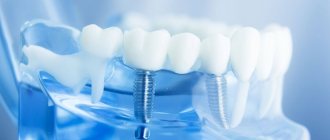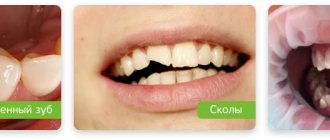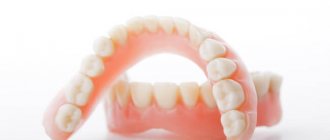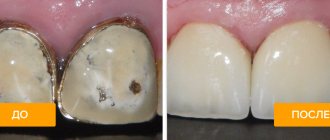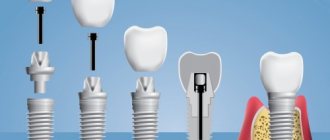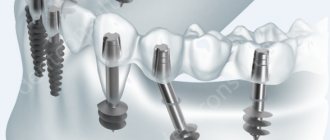Which implants are best? A rating of 10 manufacturers will help you choose the best implants in terms of price, quality and survival time.
Every person who is faced with the problem of restoring lost teeth asks the question: “Which implants are best to place?” Unfortunately, it is not possible to get truthful and complete information about existing dental implants in every clinic and not from every dentist. As a result, patients rely on tempting but dubious offers from doctors regarding the installation of a particular implantation system, and often become hostage to low-quality treatment. It is not surprising that in the future many of us are faced with such negative consequences as allergization of the body, loosening of the installed structure, slow rates of engraftment, or complete rejection of the implant.
In this case, the only way out of the situation will be to obtain detailed and reliable information about systems from different manufacturers, study the rating of dental implants and become familiar with the existing prices for them. Only in this case can you count on long-lasting, reliable and high-quality treatment results.
From this article you will learn comprehensive information about which implants are the best. We will tell you not only about the advantages of such systems, but also provide information about the prices set in modern clinics. You will also get acquainted with budget implantation systems available to most residents of our country.
Get a consultation
We will answer all your questions before visiting the clinic!
+7
Online registration
Content
How to choose the best dental implants? The likelihood of survival is the main factor in the ranking of implants
Options for prosthetics when choosing implants
Healing period for the best implants
Indications for implantation
Rating of dental implants by manufacturer 10. MIS – dental implants from Israel at an affordable price
9. XiVE implants – dental systems from Germany of decent quality
8. AnyRidge – universal implants from South Korea
7. Osstem – implants with decent characteristics from South Korea
6. Zimmer – dental implants from the USA with a unique surface
5. Anthogyr implants – top French quality system
4. Dentium (South Korea) – the best budget implants
3. Astra Tech implants (Sweden/USA) – ideal aesthetics and lifelong service life
2. Nobel Biocare implants – perfection of shape and surface
1. Straumann implants – the best dental implants in the world from Switzerland
Prosthetics on implants: reviews
You will be surprised, but most of the patients dissatisfied with implantation are not dissatisfied with the shape or color of the crowns, or the implant rejection that has occurred.
Almost 95% of all complaints relate to the unsatisfactory appearance of the gums around the neck of the implant (if we are talking about implantation in the area of teeth falling into the smile line). This is especially true for patients with a gummy type of smile. Of course, complaints about the poor aesthetics of the crowns themselves are also common (if the crown does not match the color and transparency of the surrounding teeth, standing out against their background). However, most often patients are dissatisfied with the appearance of the gums around the implant - the bluish color of the gums, the absence of gingival papillae, the occurrence of gum recession (i.e., a lowering of its level, resulting in exposure of the implant neck).
Most implantologists will try to screw in implants for you as quickly as possible so that you won’t run away anywhere. But only some implantologists know how to work with gum aesthetics. Therefore, if you are planning to implant your front teeth and have a gummy type of smile, it will be very difficult for you to find a suitable implantologist. Below we will give a couple of reasons that will inevitably cause gum problems after dentures.
- Thin gum biotype - to achieve good gum aesthetics, its thickness should ideally be at least 5 mm.
If your gum thickness is less (for example, 2-3 mm), then this means a 100% risk of poor aesthetics and the absence of gingival papillae around the implant. Even when planning implantation, the doctor must assess the thickness of the gums and plan an intervention that will forcefully increase its thickness. Such an intervention is, for example, transplanting a flap from the palate. It is most often carried out simultaneously with the installation of the implant, less often - after the end of the period of osseointegration of the implant. The meaning of the operation is that a small section of gum is taken from the palate (donor area) and sutured on the crest of the alveolar process - in the area of the installed implant. Unfortunately, such an operation quite seriously increases the cost of implantation.
- Lack of attached gums – gums around the teeth can be of 2 types: attached gums and mobile gums.
The attached gum is tightly fused to the periosteum and therefore does not move when the lips/cheeks move. The width of the attached gum around the implant should be at least 3-4 mm. If it is less, then over time the gums will detach from the implant - with the formation of a “gum pocket” and the development of peri-implantitis. As a result, there will be bluish, inflamed gum around the implant, and the inflammation will gradually lead to lowering of the gum level and exposure of the metal neck of the implant. Therefore, even when planning implantation, the doctor must assess the width of the attached gum and, if it is insufficient, perform a minor surgical intervention to increase it.
How to choose the best dental implants?
The question of why prices for dental implants differ is of concern to most patients. Of course, at first glance, the difference is almost invisible: all such structures have an identical structure in the form of a small pin with a cylindrical or cone-shaped shape. Then what is the reason for the appearance of markups on some products, and the availability of affordable prices for others?
First of all, the inflated cost is due to the popularity of the brand. This allows you to understand which dental implants are the best . If a manufacturer has been on the market for several decades (for example, ]Straumann[/anchor], Astra or Nobel), invests significant funds in scientific research and the production of more advanced dental products, then you have to pay a significant amount extra just for its authority and name.
However, it is not only company recognition that matters: clinical parameters play a key role. Next, we will talk about the main indicators that characterize individual dental implants and help you decide which ones are best to install.
The likelihood of survival is the main factor in the ranking of implants
An important parameter indicating which implants are best placed is the degree of survival. As a rule, it is considered quite high for systems from popular manufacturers (over 97%), and reaches maximum values (100%) for elite brands, as proven by numerous studies. It should be noted that the rating of dental implants according to this criterion is considered conditional, since the final result of treatment is often determined by the professional skills of the doctor and the patient’s compliance with recommendations during the rehabilitation period.
Options for prosthetics when choosing implants
This factor is of great importance, since the functional and aesthetic characteristics of the installed implants are determined by the quality of the installation of the prostheses. Each brand has its own options for prosthetics - an “orthopedic portfolio”. That is, the more solutions for fixing crowns an orthopedist has, the more opportunities open up for the patient to obtain a successful treatment result even in complex clinical cases. This also allows patients to make a choice about which implants are best to place.
What trends are expected in this area?
Unlike dentures, implants do not need to be periodically replaced with new ones . They help make your smile beautiful, natural and healthy at any age. However, their main advantage is the complete restoration of dental functions.
Nowadays there are dental structures made of different materials: titanium alloy, ceramics, biopolymer. Technology improvements continue. Thus, Spanish scientists have created completely new dental implants with a biodegradable coating. They integrate much faster into living tissues; upon contact, the coating particles gradually dissolve. This helps accelerate bone regeneration.
Our team of doctors
Maxillofacial surgeon, Implantologist
Bocharov Maxim Viktorovich
Experience: 11 years
Dental surgeon, Implantologist
Chernov Dmitry Anatolievich
Experience: 29 years
Orthopedist, Neuromuscular dentist
Stepanov Andrey Vasilievich
Experience: 22 years
Endodontist, Therapist
Skalet Yana Alexandrovna
Experience: 22 years
Orthopedic dentist
Tsoi Sergey Konstantinovich
Experience: 19 years
Dentist-orthodontist
Enikeeva Anna Stanislavovna
Experience: 3 years
Indications:
- impossibility of two-stage implantation;
- absence of 3 teeth to complete absence;
- urgency of recovery.
Resmile
. Implantation technology without cuts or sutures. The transgingival method of implanting a titanium root is atraumatic, healing occurs quickly. The combination of implants from one system increases the success rate and minimizes complications. This is facilitated by a titanium-based ceramic composite prosthesis, which is installed on the 4th day and does not require replacement subsequently; it is permanent.
Get a consultation
We will answer all your questions before visiting the clinic!
+7
Online registration
Healing period for the best implants
On average, the time for osseointegration of dental implants using the traditional method is close to 6 months. However, today many manufacturers are introducing the latest developments, due to which they can reduce this period to 4-8 weeks.
Some patients consider this point to be the most important when searching for an answer to the question: “Which are the best dental implants?”
Indications for implantation
Most companies offer implantation systems that can be used in one-stage and two-stage techniques. The possibility of implant fixation in case of hepatitis, diabetes mellitus and insufficient bone tissue is already the prerogative of top brands. Not all manufacturers use technologies that allow the installation of dental implants in the presence of serious restrictions. However, if you are wondering which dental implant is better, this is a point you should pay attention to. High-quality systems produced by prestigious companies are usually allowed for fixation if there are contraindications.
Indications:
- absence of several teeth or complete edentia;
- a complex clinical case that requires a particularly careful approach.
Implantation
All-on-4 and All-on-6
. Modern dental implantation “All on four” or “All on six” allows you to reduce the financial burden of restoring the entire dentition. By implanting only 4 or 6 titanium rods, you can install a complete denture on the jaw with 10-12 artificial crowns. Installing an implant instead of each tooth would require more money and time.
Rating of dental implants by manufacturer
The active use of implants in Western countries began several decades ago; in our country, this technique has become popular only recently. That is why, in order to demonstrate as accurately as possible the popularity of implantation systems of different brands, we took statistical data for the countries of Europe and the USA as a basis. At the same time, the characteristic features and advantages of manufactured implants were taken into account.
- MIS (Israel)
- Xive (Germany)
- AnyRidge (South Korea)
- Osstem (South Korea)
- Zimmer (USA)
- Anthogyr (France)
- Dentium (South Korea)
- Astra Tech (Sweden/USA)
- Nobel Biocare (Switzerland/USA)
- Straumann (Switzerland)
All the manufacturers presented above are popular and have a fairly high cost. However, today you can find companies manufacturing implants with decent characteristics and at reasonable prices. Among such brands, ]Dentium[/anchor] occupies an important place (located in 5th place in the ranking). Also in the domestic market, the products of the Korean company Osstem are in wide demand, offering reliable implants to patients at affordable prices.
Next, you will learn about the advantages of the systems included in the rating above. This will allow you to explore the different types of dental implants and see which ones are best.
MIS – dental implants from Israel at an affordable price
Any dental implants have characteristics that directly affect the quality of engraftment in bone tissue. These include: surface properties, biological compatibility, as well as the nature and shape of the thread. Next we will consider MIS systems in accordance with these parameters:
- Surface. MIS implants have a standard SLA surface obtained by sandblasting followed by acid etching. Thanks to the use of such a coating, it is possible to increase the degree of engraftment by 25%. Despite the decent quality of this surface, it has average hydrophilic qualities.
- Biocompatibility. To obtain implants of this type, a popular titanium alloy is used, which contains admixtures of vanadium and aluminum. This increases the strength of the structure, but has a negative impact on osseointegration.
In general, prices for MIS implants are considered the most acceptable among other analogues. So, for fixing one unit you will have to pay only 20 thousand rubles. Together with the installation of a ceramic crown, the amount will be from 50 thousand rubles and above. To fix a metal-ceramic crown, you will need another 15 thousand rubles.
XiVE implants – dental systems from Germany of decent quality
XiVE implants have an improved surface and microporous structure, which promotes rapid osseointegration and reduces the likelihood of side effects. Another important advantage is the presence of threads with a combined design: the narrow part in the middle provides maximum stabilization after fixation, the wide part at the end facilitates the process of implantation into the bone tissue.
In addition, implantation systems of this brand are made from purified titanium material, without any additives, which has a positive effect on their characteristics.
The versatility of the manufactured XiVE abutments deserves special attention, which allows dental implants of any diameter to be fixed to them.
Each model has its own serial number, which eliminates the possibility of implant counterfeiting. As for the “disadvantages” of such dental systems, they are, first of all, associated with insufficient brand recognition in the domestic market.
8. AnyRidge – universal implants from South Korea
AnyRidge systems have several characteristic features that make them one of the best budget dental implants:
- Unique Xpeed surface. Thanks to the use of calcium ions when creating the coating of AnyRidge implants, it is possible to significantly accelerate the process of osseointegration;
- Increased strength. In the manufacture of systems of this brand, purified titanium material is used, which guarantees impeccable quality, hypoallergenicity and maximum reliability;
- Improved connection to the abutment. Due to the five-degree connection, the possibility of unwinding the fixing screw and loosening of permanent dentures is eliminated;
- Knife Thread available. The cone-shaped design promotes the process of chewing food with uniform load distribution;
- High installation comfort. The process of fixing Eniridge dental implants is carried out using one drill, which minimizes the degree of tissue trauma and reduces the cost of implantation;
- Increased surface. This ensures identical quality of installation of both elongated and shortened implants, and also eliminates the need for osteoplasty (sinus lift);
- Perfect aesthetics. It is distinguished by ideal aesthetic indicators, identical to natural teeth;
- Versatility. Thanks to a wide selection of sizes of orthopedic structures, it is possible to restore teeth even in difficult clinical situations.
Taking into account the above advantages, we can confidently answer the question: “Which dental implants are best to place?” This manufacturer offers patients universal systems with quite decent aesthetic and functional parameters.
7. Osstem – implants with decent characteristics from South Korea
The classic Osstem TS system is the most popular among patients. Important features of these implants include the presence of a triple connection with the adapter and a double thread with the ability to self-tapping.
Currently, the following implant models are manufactured under the above brand:
- TS II SA. A distinctive feature of this system is the presence of an acute apex and the necessary indicators of initial stabilization;
- TS III SA. This line of implants is characterized by versatility - due to the cone-shaped shape and the cutting edge of the helical structure, they can be used even in the most unusual situations;
- TS IV SA. They are distinguished by stronger fixation and maximum stability, which is facilitated by the presence of self-tapping threads;
- TS III CA. The most modern system of this South Korean brand, which has a hydrophilic surface and self-tapping thread, thereby minimizing the healing period.
When the best dental implant manufacturers are considered, Osstem occupies a separate position in this ranking. This is due to the possibility of producing solid structures, which are used in the absence of the required bone tissue dimensions and are suitable for installation as part of an instant procedure.
Read more about Osstem implants »
Indications:
- absence of most teeth or complete edentia;
- inability to wear a removable lamellar denture.
This modern implantation method allows people with removable dentures to securely fix it.
Complex implantation
. “All inclusive” in dental treatment. In one visit to the dentist, teeth are removed (if necessary) and an implant is inserted. A method for immediately restoring multiple teeth. Prosthetics on 6-12 implants with a fixed prosthesis.
Get a consultation
We will answer all your questions before visiting the clinic!
+7
Online registration
6. Zimmer – dental implants from the USA with a unique surface
Systems of this brand are included in the rating of the best dental implants, since their production is based on a unique technology that allows obtaining a trabecular surface structure. Due to it, the ability of bone tissue and the structure to mutually “build” into each other is achieved, which has a beneficial effect on the rate of osseointegration.
Also among the distinctive features that allow these designs to be included in the rating of competitive implants:
- Significant area of contact with bone. Provides the possibility of implantation even in the absence of the required bone tissue sizes;
- Possibility of quick fixation of prostheses due to short healing times;
- The use of a material (tantalum) that is fully compatible with the human body;
- A unique connection between the dental implant and the adapter, thanks to which the tightest possible contact of the component parts is achieved and the risk of microbes is eliminated.
5. Anthogyr implants – top French quality system
These systems are in 5th place in the presented ranking of implants, which is due to the presence of the following positive qualities:
- Possibility of installation directly after tooth extraction;
- Can be used with various types of orthopedic structures;
- These implants can be used both within the framework of the classical technique and for an instant procedure;
- They have a minimal period of osseointegration, which is facilitated by an improved porous coating;
- They are distinguished by their versatility. The use of such structures is allowed even if the quality of the bone tissue is low or if its size is insufficient;
- Possibility of performing surgical intervention in a shortened time;
- They are famous for their ease of installation, which reduces the likelihood of injury to nearby tissues;
- Can be used with both zirconium and titanium transition elements;
- The Antogir product line includes implants suitable for fixation in a limited area of the defect;
- Help prevent reduction in bone tissue size.
If we talk about the negative features of these systems, they are associated, first of all, with the use of a planar-type transition element. This, in turn, can create a distance between system components and cause the fixing screw to loosen.
Read more about Anthogyr implants »
4. Dentium (South Korea) – the best budget implants
The above-mentioned Korean systems were included in the ranking of dental implants not by chance - in terms of quality and prices, they meet the needs of modern patients and the requirements of experienced specialists. Among the main factors for the company's success are:
- The best budget implants;
- Impeccable quality;
- Versatility. Through the use of these dental systems, it is possible to select the appropriate implant and adapter option for each specific clinical case. In this case, the use of Dentium implants is allowed when implementing the instant technique;
- Easy to install. When fixing such implantation systems, the possibility of the slightest error is eliminated, which is ensured through the use of an improved drill system;
- Providing a guarantee. All Dentium systems have a full warranty. However, if there is a problem with the structure coming off, you can expect a quick and free replacement.
Read more about Dentium implants »
Removable prosthetics on implants –
Patients with complete absence of teeth know very well that the fixation of dentures on a toothless jaw leaves much to be desired, and every year it gets worse (due to the gradual atrophy of the bone tissue under the denture). And removable prosthetics on dental implants solves this problem.
In this case, implants are installed under the prosthesis to ensure its excellent fixation. This happens thanks to special locking fasteners, which consist of two parts. The first half of the locks is screwed into the implants, the second is installed in the plastic base of the removable denture (in the projection of the implants). When putting on the denture, the locks snap into place, and the denture is securely fixed in the oral cavity.
There are 2 types of fixation of removable dentures to implants -
- “Push-button” fixation, which can be achieved using either ball-shaped abutments or equatorial abutments of the Locator® system (Fig. 14),
- beam type fixation (Fig. 15).
1) Fixation on spherical and equatorial abutments –
First, 2-4 implants are installed in a toothless jaw: it is optimal to install 4 implants on the upper jaw, 2 or 3 are acceptable on the lower jaw. Next, abutments are screwed into the implants, which will protrude above the surface of the mucous membrane and will be part of the removable denture fixation system. At the moment, two types of abutments can be used - spherical or equatorial abutments of the Locator® system.
Next, in the body of the removable denture (in the projection of the installed implants), recesses are made into which silicone matrices are inserted. When putting on the prosthesis, the silicone matrices tightly grip the abutments and thus securely hold the prosthesis. After this, the latter can be removed only by applying sufficient force. The cost of such a prosthesis starts from 90,000 rubles (for 2021).
Fixation of the prosthesis on equatorial abutments (Locator®) –
This article is for informational purposes only, and you can learn as much as possible about the options for this type of prosthesis (using spherical abutments, Locator® system abutments), and find out the advantages and disadvantages of each fixation option in the article: → “Conditionally removable prosthetics on implants”
2) Beam type fixation –
Fixing a removable denture on a metal beam is a very effective, but very expensive fixation option (it will cost about 2-3 times more than the previous option). The high cost is explained by the complexity of manufacturing such a fixation system, however, chewing efficiency and chewing comfort will be maximum in this case.
Fixation of the prosthesis on a metal beam –
The metal beam can be fixed on 2-4 implants. Normally, there should be exactly 4 of them, but in order to save money, the beam is often made with support from 2-3 implants. The latter leads to the fact that the prosthesis will be well fixed only in the area of the front teeth, and in the area of the back teeth it will be balanced. In the projection of the metal beam in the body of the prosthesis, a recess is made into which several silicone matrices are inserted (Fig. 18). For more information about this type of prosthesis, see the link above.
Sources:
1. Add. professional
, 2. Personal experience of a dental surgeon (implantologist), 3. National Library of Medicine (USA), 4. “Prosthetics supported by implants” (Wohlfart Sh.), 5. “Dental prosthetics on implants” (Surov O.N. . ), 6. Mayo Clinic, USA.
Get a consultation
We will answer all your questions before visiting the clinic!
+7
Online registration
Astra Tech implants (Sweden/USA) – ideal aesthetics and lifelong service life
When considering implants from various manufacturers, their quality rating and price, it is impossible to ignore the products of the famous Swiss brand Astra Tech. In the production of such implantation systems, purified titanium is used, which has a beneficial effect on the process of osseointegration.
Special attention should be paid to the improved OsseoSpeed™ coating, which is used to create Astra implants. According to numerous clinical studies, such a surface has the most important advantage of accelerating the process of bone formation. Moreover, such structures are characterized by impeccable initial stabilization and the shortest healing time.
Also, a significant “advantage” that allows you to add the above-described dental systems to the rating of the best dental implants is the use of MicroThread™ microthreads. Due to this innovation, it is possible to optimize the pressure on the cortical region of the bone tissue.
The conical connection between the implant and the adapter is also important, which also contributes to the correct distribution of pressure on the deep layers of bone tissue and eliminates the possibility of loss of bone tissue in the neck area. To understand which implants are the best, it is necessary to take into account the reviews of doctors and patients about each system used. Thus, according to the majority of specialists and visitors to dental clinics, Astra dental implants have perfect aesthetic parameters and improved functional characteristics. In addition, they are suitable for use in the most difficult situations. At the same time, an important advantage of such structures is their long operational period – up to 20 years.
Read more about Astra Tech implants »
2. Nobel Biocare implants – perfection of shape and surface
The success of this manufacturer is based on the use of an improved TiUnite coating, which guarantees impeccable quality and an accelerated osseointegration process. A distinctive feature of such a surface is the presence of moderate roughness and an impressive number of micropores, which promotes the fastest possible engraftment and prevents the likelihood of serious complications for the patient’s body.
When a patient asks the question: “Which implant is better?”, the Nobel system is undoubtedly the winner. This is due to the following positive aspects:
- If we talk about which implants are better, then it is necessary to take into account such an indicator as primary stability. With Nobel implantation systems, the necessary initial stabilization is possible even in loose bone tissue. This expands the possibilities for using such structures - they can be used both as part of a classical procedure and for a one-stage technique.
- In addition, the above systems have an aggressive profile at the bottom, which guarantees the ability to self-screw and form threads on bone walls.
- In order to reduce pressure on bone tissue and form a beautiful gingival contour, the neck of the implant has a reverse-conical structure in the upper part.
- Due to the conical shape of the NobelReplace and Replace Select Tapered models, it is possible to achieve the required initial stabilization even with immediate cementation of crowns.
Read more about Nobel Biocare implants »
Straumann implants – the best dental implants in the world from Switzerland
As you know, the Strauman implant is considered the best in the world due to the following advantages:
- Impeccable product quality and lifetime service life. It was possible to obtain such positive effects due to 35 years of scientific experience and the active implementation of innovative technologies;
- Solid experience in the field of implant installation. Since the company opened, over 14 million procedures have been performed with Strauman implant systems;
- Possibility of reducing the engraftment period to 1-2 months, which is achieved through improved coating;
- If we consider the best dental implants and their rating, Strauman systems undoubtedly occupy a leading position. This is due to unsurpassed aesthetic indicators, accelerated rates of osseointegration, excellent compatibility with the human body and the ability to withstand increased chewing loads;
- An important factor that allows you to understand which dental implants are the best is the possibility of fixation even in the absence of sufficient bone tissue. This manufacturer offers users dental systems with a minimum diameter, made of the improved Roxolid alloy. This eliminates the possibility of osteoplasty (sinus lift);
- Providing a lifetime warranty on all installed dental implants;
- The use of a unique SLA surface, which significantly accelerates the process of osseointegration. This gives a comprehensive answer to the question: “Which implant survives better?” According to the results of many years of research and development, Straumann implants show a 99% survival rate. In addition, such a coating eliminates the possibility of peri-implantitis.
Based on the above facts, we can confidently say that the best dental implants are Strauman systems, which is confirmed by the rating (1st place in the list) and the presence of unique characteristics.
Read more about Straumann implants »
Author:
Implantation with late loading (3-6 months) –
Prosthetics on implants after 3-6 months are called late or delayed loading. Such terms are the safest for the patient due to the fact that the risk of implant failure is minimal. You need to understand that as soon as the crown is fixed on the implant, chewing pressure immediately begins to be exerted on it. And despite the fact that it is believed that an adequate level of early chewing load can contribute to the speed of fusion of the implant with the bone, nevertheless, when prosthetics are performed before the completion of the period of osseointegration, there is still a greater risk of implant failure.
There are 2 implantation methods, in which prosthetics are performed within 3-6 months. These include the classic two-stage technique, as well as the one-stage implantation technique. It is important to consider that the indicated dates are correct only if implantation is carried out without simultaneous bone grafting. If, when installing implants, bone augmentation is also carried out, the time period increases by several more months.
1) Two-stage implantation technique –
The term “two-stage” means that the surgery will be performed in 2 stages. At the first stage, the implant is installed in the bone, after which the mucous membrane above it is sutured tightly. During the second stage, i.e. after 3-6 months, the mucous membrane above the implant is cut, and a healing abutment (gum former) is screwed into the implant for 10-14 days, which is necessary to form a beautiful gum contour around the neck of the implant. And only after this the prosthetics are performed.
Clinical case No. 2 –
The first stage of surgery (implant installation).
The second stage of surgical intervention (after 3 months) involves opening the mucosa above the implant and installing a gum former into it. And after another 2 weeks, a ceramic abutment and a zirconium dioxide crown are installed.
Important: this is the safest technique, the use of which allows you to minimize the risk of inflammation around the implants and their rejection. This occurs due to the fact that implant healing occurs under a tightly sutured mucous membrane; accordingly, in this case there is no contact of the osseointegration zone with the microbial environment of the oral cavity.
2) One-stage implantation technique –
The difference from the previous technique is that the gum former is screwed into the implant immediately after it is installed in the bone, and not after several months. The only advantage of this technique is that it saves several weeks on shaping the gum contour. There are more disadvantages, for example, a higher risk of developing peri-implantitis (inflammation around the implant).
This technique should be preferred only when we are planning early loading of the implant. But using it in smokers, patients with osteoporosis, diabetes, chronic periodontitis or a number of other diseases is certainly undesirable. See below how the one-stage implantation technique is carried out.
Clinical case No. 3 –
The first stage is the installation of the implant immediately along with the gum former.
The second stage is prosthetics 4 months after the operation (a titanium abutment and a metal-ceramic crown are installed in place of the gum former).
How to choose between implants from different manufacturers -
To learn how implants from different manufacturers differ from each other, how to choose between them, and what characteristics you should pay special attention to, read the article:
→ How to choose the right type of dental implant
Price
Modern dental implantation is more expensive than prosthetics. The cost of treatment depends on several factors:
- chosen method;
- use of a surgical template;
- number of implants;
- company manufacturer;
- material of prosthesis, crown;
- qualification of an implantologist.
For example, the price of one-stage implantation with a temporary crown is about 40,000 rubles, the All-on-4 technology of one jaw with an adaptive prosthesis will cost from 190,000 rubles, one-stage implantation with complete edentia of one jaw on 6 compression implants and a temporary prosthesis - in the region RUB 265,000 The cost item may increase due to additional diagnostics and prosthetic materials.
Lamellar
Plate implants
The intraosseous part is a wide thin plate with a textured surface (macrorelief in the form of a snake or corrugated structure) and holes. Such implants are practically not used, as they have more disadvantages than advantages.
Firstly, they differ in shape from the roots of natural teeth, thus they are not able to withstand and distribute the chewing load in the proper volume. Therefore, the service life is not long.
The only positive thing that can be noted is the low cost.
Where to go for the latest generation of dental implants
Only dental clinics with technologically advanced diagnostic and surgical equipment and highly qualified staff can offer a choice of modern methods of dental implantation and a guarantee for their work.
The table shows several Moscow clinics where you can restore a beautiful smile in an advanced way. We advise you to find out the cost and current promotions directly on their websites.
| dental clinic | Website |
| Center for Dental Implantology ROOTT (RUTT) | https://dentalroott.ru |
| Dentum dentistry | https://dentumclinic.ru |
| City-Dent | https://city-dent.rf |
| The president | https://www.prezi-dent.ru |
| Center Family Dentistry | https://family-dental.ru |
Why do sixth teeth need restoration more often than others?
The sixth teeth (or first molars according to dental classification) are classified as molars. They are laid at the 5th month of intrauterine development, mineralization begins from the 9th month of the intrauterine period, and continues for another month after the birth of the child. The enamel of the “tooth germs” located in the jaw bone finally matures by 1-2 years. The correct formation of molars depends on the course of pregnancy and childbirth.
Molars do not appear at an early age; they do not have predecessors (baby teeth). They begin to erupt at 5-6 years of age, the first of the permanent radical units. The structure of the first molars differs from other teeth of the chewing group - the maxillary sixes have three roots and four canals, the mandibular sixes have two roots and three canals. These are the largest molars, characterized by a wide tuberous surface.
The chewing group, in particular the first molars, are most susceptible to the destructive effects of bacteria and excessive mechanical stress. This is the main cause of irreversible damage to the tooth structure and its loss.
Combined
The shape and size of such implants are determined strictly individually, depending on the number of lost teeth, the thickness of the jaw bone and other factors.
Highlight:
- Lamellar-root-shaped;
- Disc: for weak, atrophied bone in cases where bone grafting is impossible;
- Transosseous: used for severe atrophy of the jaw bone, installed through an incision in the chin area;
- Ramus-frame dental implants: a fairly extensive design that covers almost the entire jaw. It is used for severe bone atrophy and serves as a support for both removable and fixed prostheses.
Such implants are used only in cases where screw installation is not possible. The operation requires more time, the process is complex and traumatic . The recovery period is much longer, and the service life is short.
Maintenance and care of the prosthesis –
Permanent dentures All-on-4 require a very careful attitude. If you previously had a regular removable denture and cleaning it from plaque and food debris was quite simple, now your time spent on hygiene will immediately increase several times. Unfortunately, this comes at a price for the opportunity to have completely permanent dentures. The biggest difficulty is cleaning the underside of the denture.
A fixed denture does not “lie” on the gums, and between the gum and the lower surface of the denture there will be a rinsing space - where food debris will certainly fall. And, accordingly, with insufficient hygiene, plaque and tartar will be deposited on the lower surface of the denture. To prevent this, it will be necessary to regularly use an oral irrigator, as well as use special super-flosses. In addition, regular cleaning of the denture with a soft toothbrush will be required.
Professional denture maintenance – approximately once every 6 months you will have to visit the dental clinic for a professional cleaning session of the denture (for patients with poor hygiene – once every 3 months). To do this, the screws that secure the bridge to the implants are unscrewed, and the prosthesis is removed from the mouth. The lower surface of the prosthesis is professionally cleaned and polished, and then the prosthesis is again fixed to the implants using screws.
An important point is that the quality of hygiene of the lower surface of the prosthesis will depend not only on your efforts. When making a denture, a dental technician may make mistakes that may not allow the patient to clean the lower surface of the denture at all. Normally, the lower surface of the prosthesis should have a convex shape, but very often we see that the lower surface of the prosthesis is given a concave shape (Fig. 24-25) - it becomes impossible to clean such a surface with floss.
Therefore, patients with a concave shape of the lower surface of the prosthesis always have a large amount of tartar on the prosthesis, always have bad breath, as well as inflammation around the implants, which over time can lead to failure of all implants. But let's see what else you need. Patients with titanium-polymer dentures will have to replace artificial teeth in the denture approximately once every 7 years. The fact is that teeth made of acrylic plastic or ceramic composite gradually wear out (this happens especially strongly in the chewing areas).
Wearing of the chewing teeth will lead to a decrease in the height of the bite in the chewing sections and, accordingly, to an increase in the chewing load on the front teeth (which sooner or later will not withstand the load and will break).
Why is there a risk of rejection?
No manufacturer or dentist can claim that an implant will not be rejected 100%, since sometimes a complication occurs simply due to the body’s individual reaction to a foreign body.
The guarantee provided by dentistry is to protect the patient from complications in the event of rejection:
- due to a doctor’s error during installation (failure to comply with sanitary standards, incorrect installation, etc.);
- due to inconsistency of product quality.
If the patient did not follow the recommendations, or the implant was rejected after 2 - 4 years or more, then we are not talking about a medical error or poor quality. Most likely, pathological processes are occurring in the patient’s body, which become the cause. In such cases, the clinic, of course, does not bear responsibility.
Note! According to statistics, implants are rejected in only 2% of patients.
